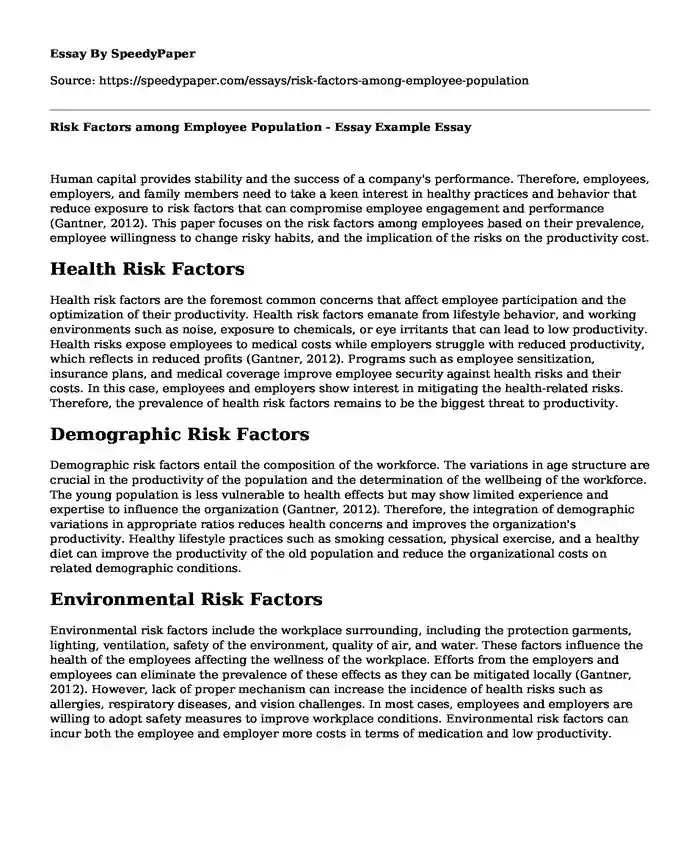
| Type of paper: | Essay |
| Categories: | Risk Human resources Behavior Risk management |
| Pages: | 3 |
| Wordcount: | 601 words |
Human capital provides stability and the success of a company's performance. Therefore, employees, employers, and family members need to take a keen interest in healthy practices and behavior that reduce exposure to risk factors that can compromise employee engagement and performance (Gantner, 2012). This paper focuses on the risk factors among employees based on their prevalence, employee willingness to change risky habits, and the implication of the risks on the productivity cost.
Health Risk Factors
Health risk factors are the foremost common concerns that affect employee participation and the optimization of their productivity. Health risk factors emanate from lifestyle behavior, and working environments such as noise, exposure to chemicals, or eye irritants that can lead to low productivity. Health risks expose employees to medical costs while employers struggle with reduced productivity, which reflects in reduced profits (Gantner, 2012). Programs such as employee sensitization, insurance plans, and medical coverage improve employee security against health risks and their costs. In this case, employees and employers show interest in mitigating the health-related risks. Therefore, the prevalence of health risk factors remains to be the biggest threat to productivity.
Demographic Risk Factors
Demographic risk factors entail the composition of the workforce. The variations in age structure are crucial in the productivity of the population and the determination of the wellbeing of the workforce. The young population is less vulnerable to health effects but may show limited experience and expertise to influence the organization (Gantner, 2012). Therefore, the integration of demographic variations in appropriate ratios reduces health concerns and improves the organization's productivity. Healthy lifestyle practices such as smoking cessation, physical exercise, and a healthy diet can improve the productivity of the old population and reduce the organizational costs on related demographic conditions.
Environmental Risk Factors
Environmental risk factors include the workplace surrounding, including the protection garments, lighting, ventilation, safety of the environment, quality of air, and water. These factors influence the health of the employees affecting the wellness of the workplace. Efforts from the employers and employees can eliminate the prevalence of these effects as they can be mitigated locally (Gantner, 2012). However, lack of proper mechanism can increase the incidence of health risks such as allergies, respiratory diseases, and vision challenges. In most cases, employees and employers are willing to adopt safety measures to improve workplace conditions. Environmental risk factors can incur both the employee and employer more costs in terms of medication and low productivity.
Behavioral Risk Factors
Employees have full control over behavioral risk factors as they reflect on individual habits such as smoking, drinking, and physical exercise. Unhealthy lifestyle practices may lead to conditions such as cardiovascular diseases, diabetes, obesity, and cancer, which can lead to reduced employee performance and the organization's productivity (Gantner, 2012). Employee sensitization programs can promote healthy lifestyle practices that influence the workforce's well-being and financial stability.
Conclusion
Employers, employees, and governments all play a role in managing the risks associated with the factors mentioned above to better their productivity. The injuries and diseases that the risks pose compromise their health affecting organizational performance and financial constraints. The risk factors can be prioritized based on the severity of health risks on top of the list, followed by environmental hazards, behavioral, and demographic risk factors. The acceptance rate in participation in mitigation practices varies across the various categories. The overall financial impact of the risk factors affects the employees on medical and other related expenses, while organizations may struggle with employee medical covers as well as reduced productivity.
References
Gantner, R. K. (2012). Workplace Wellness: Performance with a Purpose, Achieving Health Dividends for Employers and Employees. Well, Works Publishing.
Cite this page
Risk Factors among Employee Population - Essay Example. (2023, Oct 16). Retrieved from https://speedypaper.net/essays/risk-factors-among-employee-population
Request Removal
If you are the original author of this essay and no longer wish to have it published on the SpeedyPaper website, please click below to request its removal:
- Free Essay on the Studies by Julia Kristeva on the Subject of the Abject
- Free Essay Sample on Leadership Theories
- Essay Example on Listening Skills in Conflict Management
- Essay Sample about Internet Marketing Plan for the Tournament
- Free Essay on How Advertising Today Reinforces Racism and Racist Stereotypes
- The Greek Financial Crisis, Essay Example
- Essay Sample on Understanding and Managing Pain
Popular categories




